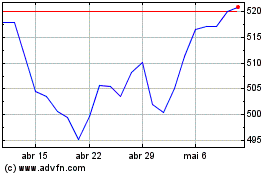Will the S&P 500 Index Continue to Rise In The Next Week?
07 Agosto 2022 - 6:28PM
Finscreener.org
The U.S. benchmark indices posted
mixed performance in the last five trading sessions but ended the
week in the green. Strong jobs reports and falling global crude oil
prices weighed on the S&P 500 index (AMEX:
SPY) and Nasdaq
Composite, which declined marginally on Friday. The Dow
Jones Industrial Average index, on the other hand, lost 0.13%
last week.
Strong jobs report
The U.S. labor market has
remained sturdy despite the global economic slowdown and recession
concerns. The economy added 528,000 non-farm payroll jobs last
month, higher than the consensus estimate of 250,000
jobs.
July marked the
19th consecutive month of non-farm payroll expansion,
with the U.S. achieving full labor market recovery since the
pandemic. Also, the unemployment rate in the economy fell by 10
basis points month-over-month to a pre-pandemic low of
3.5%.
Recession concerns loom large
This impending recession will be
like no other. While strong macroeconomic data such as
better-than-expected jobs reports and consumer spending reflects
economic resiliency, it also signals a more aggressive Fed
stance.
Analysts and traders are now
expecting an “unusually large” rate hike in September, as the
economy remains red-hot despite two consecutive 75-basis point rate
hikes over the past few months. This comes as U.S. GDP declined for
two consecutive quarters in the first half of
2022.
Around 68% of traders now expect
the Fed overnight funds rate to be in the 3%-3.25% range. This
could potentially eliminate the chances of a “soft landing,” as the
Fed is poised to implement a third 75-basis point hike next month,
marking the fastest rate hike in more than a
generation.
Regarding this Jim Baird, chief
investment officer at Plante Moran Financial Advisors said, “The
fact of the matter is this gives the Fed additional room to
continue to tighten, even if it raises the probability of pushing
the economy into recession … It’s not going to be an easy task to
continue to tighten without negative repercussions for the consumer
and the economy.”
Declining oil prices
In other news, oil prices dropped
sharply last week, signaling a global economic slowdown. On August
4, oil prices dropped to their lowest levels since the Russian
invasion of Ukraine, as U.S. crude oil inventories remained
unexpectedly high. The U.S.-benchmark West Texas Intermediate
crude
futures closed below $90 per barrel last week, marking a weekly
decline of 9.74%. Moreover, as OPEC+ is gearing to raise output in
September, the oil price weakness is expected to continue in the
near term.
The declining oil prices are one
of the key indicators pointing towards recession. The economy’s
manufacturing output declined sequentially last month as well, due
to weaker demand.
Bottom line
The U.S. Treasury yield curve has
remained inverted for a month straight – another parameter
signaling a recession. In fact, the difference between the 2-year
and 10-year
treasury yields is at the widest level in 22 years since the
dot-com bubble.
Thus, even with a strong jobs
report, the U.S. is inevitably headed toward a recession. Markets
are now keenly awaiting the July Consumer Price Index scheduled to
release next week, which would point out whether inflation rates
are cooling.
SPDR S&P 500 (AMEX:SPY)
Gráfico Histórico do Ativo
De Mar 2024 até Abr 2024

SPDR S&P 500 (AMEX:SPY)
Gráfico Histórico do Ativo
De Abr 2023 até Abr 2024
